Maritime transport of goods - quarterly data
Data extracted in July 2024
Planned article update: 30 October 2024
Highlights
829 million tonnes of goods were handled in the main EU ports in the fourth quarter of 2023.
The gross weight of goods handled in the main EU ports decreased by 3.0 % in the fourth quarter of 2023 compared with the same quarter of 2022.
Gross weight of seaborne goods handled in EU main ports (2017Q4-2023Q4)
This article presents the main results from quarterly statistics on maritime transport of goods in the European Union (EU), plus figures for Norway, Montenegro and Türkiye. It covers the gross weight of goods handled in the main European ports, by type of cargo, direction, reporting country and various partner regions. These data are complemented by maritime transport flows with the main extra-EU partners.
The article contains data for the fourth quarter of 2023. Please note that the quarterly port activity figures are provisional and subject to revisions.
Full article
Gross weight of goods handled in the main EU ports decreased by 3.0 % in the fourth quarter of 2023 compared with the same quarter of 2022
At 829 million tonnes, the gross weight of goods handled in the main EU ports increased by 2.5 % in the fourth quarter of 2023 compared with the previous quarter but decreased by 3.0 % versus the same quarter of 2022 (Figures 1 and 2).
After a steady recovery, following the economic crisis and a peak in activity reached in the second quarter of 2019, maritime transport then observed a downward trend until the second quarter of 2020, as a result of the COVID-19 pandemic. A partial recovery continued until the second quarter of 2022. After that, a new declining trend was observed, mainly attributed to the restrictions on freight transport with Russia, following its military aggression against Ukraine.
Looking at the overall annual change, EU port activity in terms of gross weight of goods handled decreased by 5.1 % compared with the previous period (Figure 2).
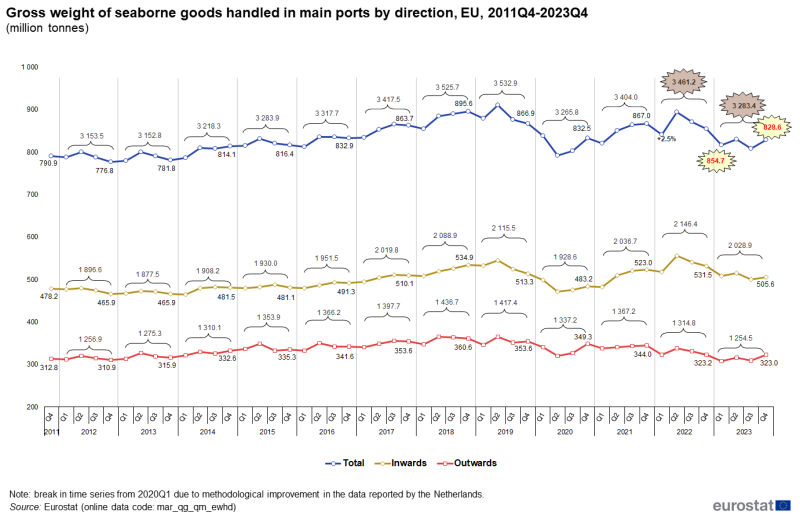
(million tonnes)
Source: Eurostat (mar_qg_qm_ewhd)
Inward movement of goods represented 61.0 % of the total volume of goods handled in the main EU ports in the fourth quarter of 2023
In the fourth quarter of 2023, 61.0 % of the total volume of goods handled in the main EU ports were inward movements. This share decreased by 0.8 percentage points (pp) compared with the previous quarter and by 1.2 pp compared with the previous year's fourth quarter.
Compared with the fourth quarter of 2022, inward movements of goods to the main EU ports decreased by 4.9 %, to 506 million tonnes in the fourth quarter of 2023. Outward movements remained relatively stable over the same period (-0.1 %), at 323 million tonnes.
When looking at the overall annual aggregate, inward movements of goods decreased by 5.5 % while outward movements fell by 4.6 %.
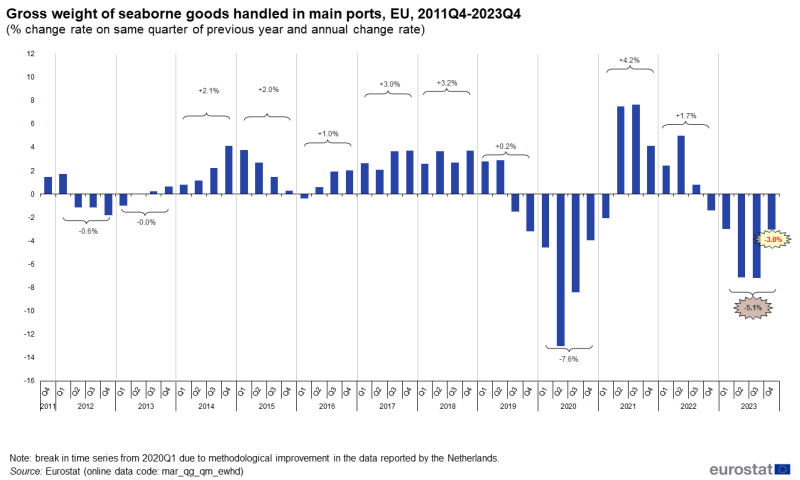
(% change rate on same quarter of previous year and annual change rate)
Source: Eurostat (mar_qg_qm_ewhd)
Dry bulk goods decreased by 11.9 % in the fourth quarter of 2023 compared with the same quarter of 2022
Compared with the same quarter of 2022, dry bulk goods (-11.9 %) fell substantially in the fourth quarter of 2023. The other types of cargo also decreased, except large containers (+4.3 %). Other cargo fell by 5.9 %, liquid bulk goods by 1.8 % and Roll on - roll off (Ro-Ro) units by 1.7 %. When looking at the overall annual change, dry bulk goods decreased by 9.1 %, other cargo by 5.8 %, Ro-Ro units by 4.1 %, large containers by 4.0 % and liquid bulk goods by 3.7 % (Figure 3).
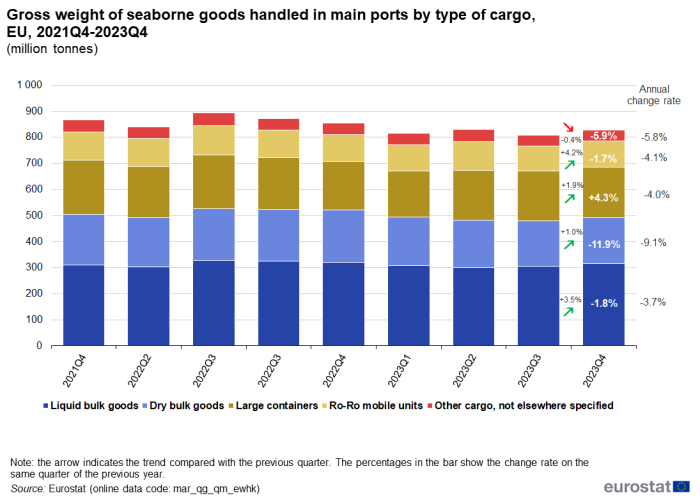
(million tonnes)
Source: Eurostat (mar_qg_qm_ewhk)
The Netherlands, Italy and Spain each handled more than 100 million tonnes of goods in the fourth quarter of 2023
In the fourth quarter of 2023, the Netherlands, Italy and Spain were the EU countries with the largest amount of maritime freight handled in their main ports, each handling more than 100 million tonnes of goods (Figure 4).
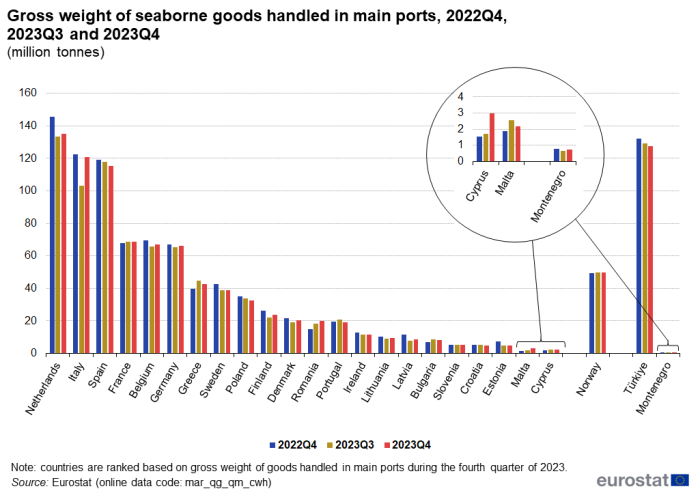
(million tonnes
Source: Eurostat (mar_qg_qm_cwh)
In the fourth quarter of 2023, 15 of the maritime EU countries recorded a decrease in the tonnes of goods handled in their main ports, compared with the same quarter of 2022 (Table 1). In relative terms, the largest decrease was observed for Estonia (-33.8 %), followed by Latvia (-28.3 %), Finland (-10.8 %), Sweden (-9.1 %), Poland (-7.7 %), Ireland (-7.3 %)and the Netherlands (-7.2 %). By contrast, Malta reported the highest increase in main port activity in this period (+93.3 %; this large change in percentage should be considered in relation to a low initial value), followed by Romania (+34.4 %), Bulgaria (+15.9 %) and Cyprus (+15.5 %), .
When looking at the overall annual change, 17 EU countries, as well as the candidate countries Montenegro and Türkiye, recorded a decrease. The largest drop was recorded by Estonia (-31.9 %), followed by Latvia (-22.6 %) and Italy (-12.7 %). The candidate country Montenegro also reported a substantial decrease of 18.2 %. By contrast, the most noticeable growth was observed in Malta (+47.5 %; this large change in percentage should be considered in relation to a low initial value), followed by Romania (+15.3 %) and Poland (+14.2 %).
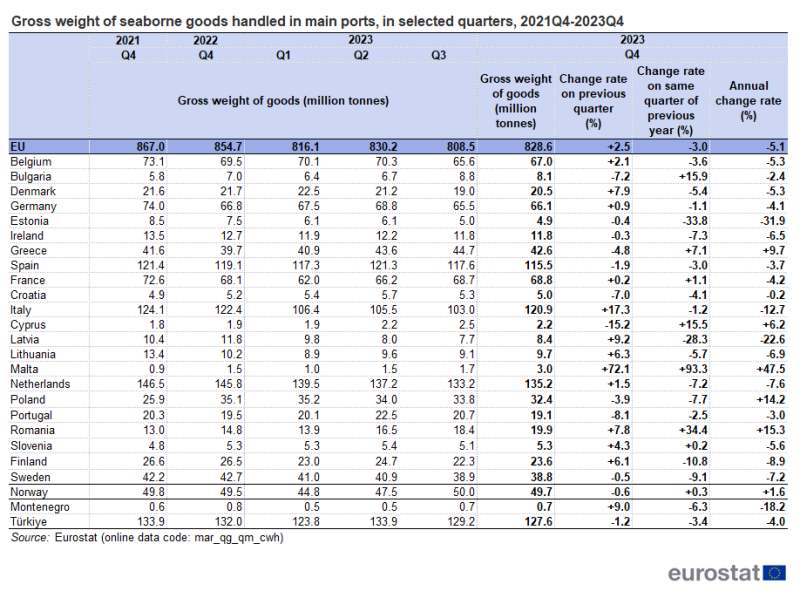
Source: Eurostat (mar_qg_qm_cwh)
In the fourth quarter of 2023, the main maritime trade flow was inward movements of crude oil from the USA
It is worth noting that the figures presented in this section may be influenced by variations in the level of transport reported with unknown partner regions. This level was particularly high in data reported in the last two quarters of 2022 and the first two quarters of 2023, compared with previous quarters and the last two quarters of 2023.
At 522 million tonnes, short sea shipping tonnages to and from the main EU ports decreased by 1.3 % in the fourth quarter of 2023, compared with the same quarter in 2022. By contrast, deep sea shipping tonnages increased by 0.8 %, to 293 million tonnes (Figure 5). When looking at the overall annual change, short sea shipping decreased by 7.2 % while deep sea shipping fell by 1.5 %, compared with the previous period.
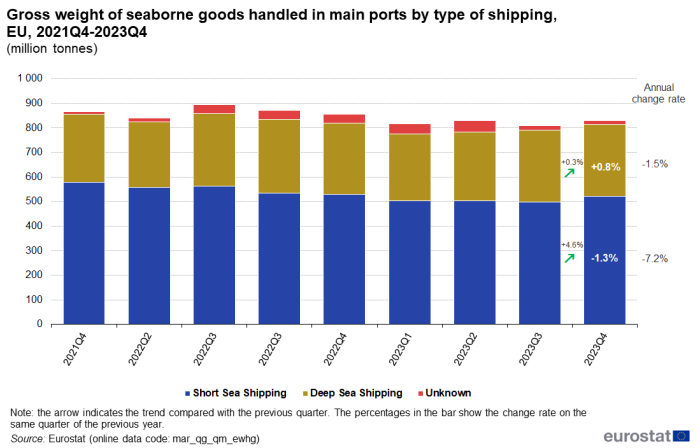
(million tonnes)
Source: Eurostat (mar_qg_qm_ewhg)
Between the fourth quarter of 2022 and the same quarter of 2023, there was a decrease in international extra-EU transport by 1.5 % whereas international intra-EU transport increased by 1.0 % and national transport by 0.6 % (Figure 6). When looking at the overall annual change, national transport decreased by 8.3 %, international extra-EU transport by 6.2 % and international intra-EU transport by 1.5 %.
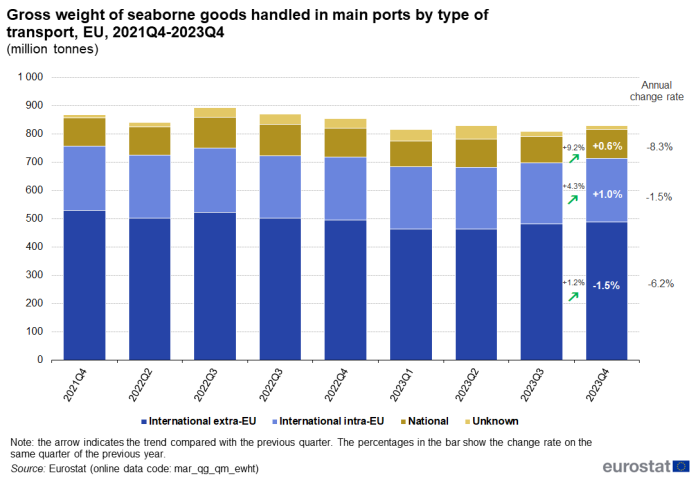
(million tonnes)
Source: Eurostat (mar_qg_qm_ewht)
The decrease in international extra-EU transport in the fourth quarter of 2023 compared with the same quarter in 2022 was mainly due to the fall in seaborne transport with ‘Europe, except for the EU’ (-16 million tonnes or -10.4 %) (Figure 7). Transport with Asia & Oceania also decreased, but more moderately (-0.8 %). By contrast, seaborne transport with America and Africa increased by 4.7 % and 4.3 %, respectively. When looking at the overall annual change, seaborne transport with America increased by +3.1 % compared with the previous period. By contrast, ‘Europe except EU’ fell substantially by 19.6 % and Africa by 0.9 %. Seaborne transport with Asia & Oceania remained stable.
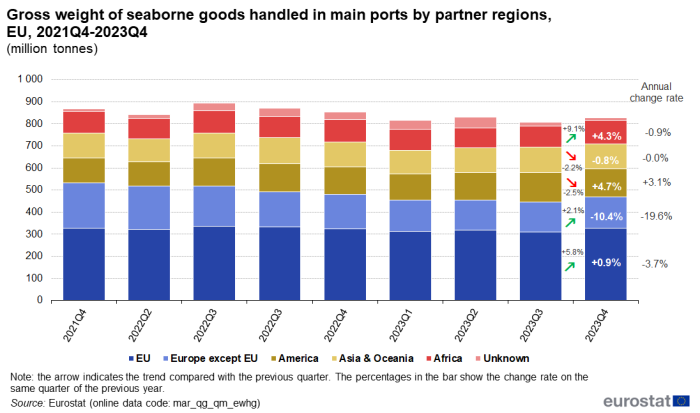
(million tonnes)
Source: Eurostat (mar_qg_qm_ewhg)
In terms of the total gross weight of goods, the United States of America (USA) remained the EU's largest maritime freight transport partner in the fourth quarter of 2023, for 7 consecutive quarters. The United Kingdom (UK) was the EU's second-largest maritime freight transport partner in the fourth quarter of 2023, followed by Norway, Türkiye, China, Egypt and Brazil . Transport with Russia remained at the eighth position, as in the second and third quarters of 2023. Canada and Nigeria completed the top 10 of extra-EU partner countries (Figure 8). EU transport with the USA and the UK together, accounted for almost one-quarter (23.4 %) of total extra-EU maritime transport.
Maritime transport between the EU and Russia recorded the largest fall in the fourth quarter of 2023 compared with the same quarter of 2022 (-44.4 %), followed by Türkiye (-7.3 %). By contrast, traffic with Egypt, the USA and Norway increased substantially over the same period, by 14.5 %, 12.0 % and 7.8 %, respectively.
When looking at the overall annual change, transport between the EU and Norway (+14.1 %), Egypt (+10.5 %) and the USA (+7.5 %) substantially increased. By contrast, the highest decrease was observed for transport between the EU and Russia (-61.8 %), followed by Türkiye (-14.1 %) and Nigeria (-8.0 %).

(million tonnes)
Source: Eurostat (mar_qg_qm_ewhp)
A substantial share of seaborne transport with the USA is made up of inward movements of liquid bulk goods to the main EU ports, in particular crude oil and liquefied gas from ports on the USA's East coast ports (Figure 9). In the fourth quarter of 2023, crude oil and liquefied gas from the USA's East coast ports represented two-fifths (41 %) of total transport between the EU and the USA. Inward movements of coal from ports on the East coast of the USA were also substantial, with 8 % of the total transport between the EU and the USAI In the fourth quarter of 2023, the main maritime trade flow was the inward movements of crude oil from the USA, with 16.5 million tonnes. Inward movements of large containers from China, fell to the second place, with 15.2 million tonnes. When looking at outward movements, large containers going to China were also the second main maritime trade flow (7.4 million tonnes), after the outward movements of Ro-Ro mobile units to the UK (11.6 million tonnes).
In the fourth quarter of 2023, the top 20 trade flows were largely dominated by inward movements of liquid bulk goods (crude oil and liquefied gas), with the following exceptions: large containers to and from China, ores from the East coast of Canada, Ro-Ro mobile units to and from the United Kingdom, other dry bulk goods from Norway, coal from the USA's East coast, as well as large containers from Türkiye and to the East coast of the USA.

(million tonnes)
Source: Eurostat (mar_qg_qm_ewh)
In the fourth quarter of 2023, compared with the same quarter of 2022, the most noticeable increases were recorded for crude oil from Brazil (+82.1 %), from the East coast of the USA (+59.1 %), from Libya (+56.5 %), oil products to the United Kingdom (+39.7 %), from Nigeria (+30.6 %), from Norway (+29.0 %), ores from the East coast of Canada (+29.0 %), liquefied gas from the East coast of the USA (+26.8 %), crude oil from Iraq (+24.5 %) as well as large containers from Türkiye (+21.4 %). By contrast, large decreases were observed for coal from the East coast of the USA (-23.9 %) and crude oil from the UK (-14.2 %) (Table 2).
When looking at the overall annual change, 9 out of the top 20 maritime trade flows grew compared with the previous period. The highest increase was registered in the inward movements of crude oil from Libya (+54.9 %), followed by inward movements of crude oil from the East coast of the USA, Norway, Iraq, Brazil, (+41.6 %, +40.7 %, +34.1 % and +33.2 %, respectively) and inward movements of liquefied gas from the East coast of the USA (+15.7 %). By contrast, the highest drops were recorded for the outward movements of oil products to the United Kingdom (-17.5 %), inward movements of crude oil from Russian ports on the Black Sea (-12.7 %) and inward movements of coal from the East coast of the USA (-11.1 %).
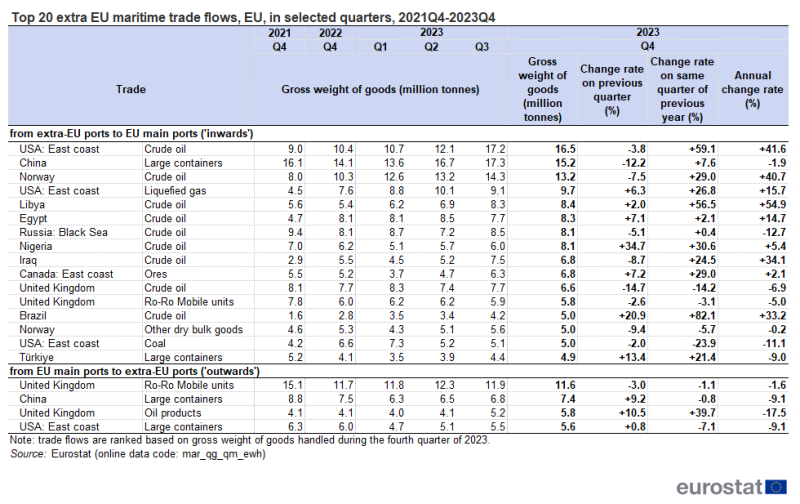
Source: Eurostat (mar_qg_qm_ewh)
Source data for tables and graphs
Data sources and availability
The content of this statistical article is based on data collected within the framework of the EU maritime transport statistics Directive 2009/42/EC on statistical returns in respect of carriage of goods and passengers by sea.
EU aggregates refer to the total of 22 maritime Member States. Czechia, Luxembourg, Hungary, Austria and Slovakia have no maritime ports. Norway and Iceland provide Eurostat with data as members of the European Economic Area (EEA). However, quarterly data are currently not available for Iceland. The EEA country Liechtenstein has no maritime ports. The EU candidate countries Montenegro and Türkiye provide data on a voluntary basis.
'Main ports' are ports handling more than 1 million tonnes of goods annually (however, data for some smaller ports may be included in the published results). Data are presented at the level of 'statistical ports'. A statistical port consists of one or more ports, normally controlled by a single port authority, able to record ship and cargo movements. All figures are based on a port's total (inward + outward) declarations. The results represent the 'handling' of goods in ports.
The 'short sea shipping' aggregate (in Figure 5) includes partner ports geographically situated in Europe, on the Mediterranean or on the Black Sea. 'Deep sea shipping' is the complementary geographical aggregate, covering maritime transport of goods on intercontinental routes, crossing oceans. A more extensive definition of 'short sea shipping' is available in the article Maritime transport statistics - short sea shipping of goods.
The concept of maritime transport trade (in Figure 9 and Table 2) is defined using the following 3 variables:
- Direction: 'inwards' transport is distinguished from 'outwards' transport.
- Partner geographical area (partner region): usually this corresponds to one country, with the exception of countries of such a size and/or geographical position that the location of individual ports may be quite different and may have a strong impact on the maritime route followed. For example, the ports of the United States of America are grouped in 2 geographical areas: East Coast (including Atlantic, Gulf of Mexico, Great Lakes and Puerto Rico) and West Coast (Pacific).
- Type of cargo: the following thirteen cargo types are used in Figure 9 and Table 2: liquefied gas, crude oil, oil products, other liquid bulk goods, ores, coal, agricultural products, other dry bulk goods, large containers, Ro-Ro mobile units, forestry products, iron/steel products and other general cargo. The first 4 types constitute 'liquid bulk', the subsequent 4 types 'dry bulk' and the last 3 types 'other general cargo not elsewhere specified', as presented in Figures 3 and 11 to 16.
Abbreviations
| : | not available |
| - | not applicable |
| Nes | Not elsewhere specified |
| Ro-Ro | Roll-on/roll-off |
| TEU | Twenty-foot Equivalent Unit |
Quarterly data are in general provisional. Revisions may be made by countries as more complete information becomes available or as a result of quality checks. More specifically, when the complete set of annual data emerges, this usually involves some revision of quarterly data for some countries.
Annual data as presented in this publication are the rolling 4 quarter totals ending in the latest quarter and the corresponding 4 quarters for earlier years. As a result, the 4 quarters included do not necessarily come from the same calendar year. For example, the 'annual' growth rate in Figure 1 shows the percentage change for the 4 quarters ending in the third quarter of 2023 compared with the 4 quarters ending in the third quarter of 2022. The basic results (in million tonnes) and the derived indicators (growth rates) shown in the figures and tables are rounded. However, they are all based on non-rounded original data, as available in Eurostat's database.
Specific remarks for data up to and including the fourth quarter of 2023:
- There is a break in time series from 2020Q1 due to methodological improvement in the data reported by the Netherlands.
- Starting from 2013 Q1, the quarterly figures for Germany include data for all national ports (both main ports and minor ports).
- The quarterly data for port activity in France have been partially estimated by Eurostat for the period 2010 Q1-2016 Q1. These data are to be considered as provisional and are likely to be revised. In general, such estimates reduce the accuracy of the statistics at detailed levels.
- Starting from 2019 Q1, the statistical coverage of data has improved for Greece, having more ports reporting quarterly data. Starting from 2021 Q1, the statistical coverage of data has again improved for Greece, having more ports reporting quarterly data.
- Starting from 2011 Q1, the quarterly figures for Spain include data for a number of regional ports outside the state-controlled port system.
- Starting from 2018 Q1, quarterly figures for Portugal include data for all national ports (both main ports and minor ports).
- Starting from 2013 Q1, the quarterly figures for Sweden include data for all national ports (both main ports and minor ports). Until 2023, data for Sweden include inland waterway transport. The share of inland waterway transport is less than 3% of all goods handled in Swedish ports.
Due to revisions of the underlying data, figures in this article may differ from figures currently or previously available on Eurostat's website.
Context
The content of this statistical article is based on data collected within the framework of the EU maritime transport statistics Directive 2009/42/EC of 6 May 2009 on statistical returns in respect of carriage of goods and passengers by sea, which is a recast of the original Council Directive 95/64/EC of 8 December 1995.
Direct access to
- Transport, see:
- Maritime transport (mar)
- Maritime transport - main annual results (mar_m)
- Maritime transport - short sea shipping - main annual results (mar_s)
- Maritime transport - passengers (mar_pa)
- Maritime transport - goods (mar_go)
- Maritime transport - vessel traffic (mar_tf)
- Maritime transport - regional statistics (mar_rg)
- Maritime transport (ESMS metadata file — mar_esms)
- Reference Manual on Maritime Transport Statistics
- Glossary for transport statistics - 5th edition - 2019
The basic legal act (Directive 2009/42/EC) has been amended by:
- Summaries of EU legislation: Statistical returns in respect of carriage of goods and passengers by sea
- Commission Decision 2010/216/EU of the EP and of the Council of 14 April 2010, OJ L 94, 15.4.2010, p. 33-40
- Regulation (EU) No 1090/2010 of the EP and of the Council of 24 November 2010, OJ L 325, 9.12.2010, p. 1-3
- Commission Delegated Decision 2012/186/EU of 3 February 2012 OJ L 101 of 11.4.2012 pp. 5-14.
The following legal acts include the last official version of the list of ports and some dissemination aspects, respectively:
- Commission Decision 2001/423/EC of 22 May 2001 (on dissemination) OJ L 151 of 07.06.2001 p. 41
- Commission Delegated Decision (EU) 2018/1007 of 25 April 2018 supplementing Directive 2009/42/EC of the European Parliament and of the Council as regards the list of ports and repealing Commission Decision 2008/861/EC (Text with EEA relevance.), OJ L 180, 17.7.2018, p. 29–71